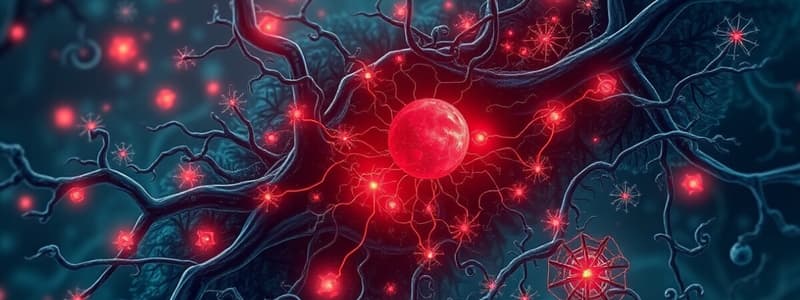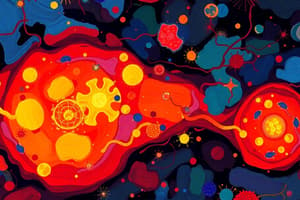Podcast
Questions and Answers
Good blood supply, or profusion, can be detrimental to wound healing if it is persistent.
Good blood supply, or profusion, can be detrimental to wound healing if it is persistent.
True (A)
Chronic inflammation is defined as inflammation lasting more than 14 minutes.
Chronic inflammation is defined as inflammation lasting more than 14 minutes.
False (B)
Increased capillary permeability during inflammation can lead to swelling as well as PHP and POP.
Increased capillary permeability during inflammation can lead to swelling as well as PHP and POP.
True (A)
During inflammation, blood vessels constrict, leading to decreased blood supply to the affected area.
During inflammation, blood vessels constrict, leading to decreased blood supply to the affected area.
Localized, generalized, and regionalized are all types of tissue necrosis.
Localized, generalized, and regionalized are all types of tissue necrosis.
The stages of acute wound healing do not overlap, which is why wound progression is always very predictable.
The stages of acute wound healing do not overlap, which is why wound progression is always very predictable.
The primary purpose of hemostasis is to prevent blood loss and prevent the growth of bacteria.
The primary purpose of hemostasis is to prevent blood loss and prevent the growth of bacteria.
Inflammation begins during hemostasis, after the platelet plug is formed.
Inflammation begins during hemostasis, after the platelet plug is formed.
The proliferation phase of wound healing involves cleaning of debris by the body, which includes the preparation of the wound so that additional tissue can grow.
The proliferation phase of wound healing involves cleaning of debris by the body, which includes the preparation of the wound so that additional tissue can grow.
Fibroblasts deposit collagen, and epithelial cells cover the new wound during the proliferation stage. Endothelial cells help to form new walls of the wounds.
Fibroblasts deposit collagen, and epithelial cells cover the new wound during the proliferation stage. Endothelial cells help to form new walls of the wounds.
Flashcards
Inflammation Prerequisite
Inflammation Prerequisite
Necessary for wound healing; good blood supply equals profusion.
Signs of Inflammation
Signs of Inflammation
Redness, swelling, heat, pain, loss of function.
Inflammation Extent
Inflammation Extent
Localized, generalized, or regionalized, based on the extent of the injury.
Wound Healing Process
Wound Healing Process
Signup and view all the flashcards
Hemostasis
Hemostasis
Signup and view all the flashcards
Inflammation Phase
Inflammation Phase
Signup and view all the flashcards
Proliferation
Proliferation
Signup and view all the flashcards
Study Notes
- Exam 2 Review
Inflammation
- Necessary for wound healing
- Good blood supply is necessary = Profusion (0)
- Beneficial, but detrimental if persistent
- Chronic => 14 days
Signs
- Redness
- Swelling (capillary permeability is increased as well, PHP, POP)
- Heat
- Pain (chemical release)
- Loss of function
- Increase in blood vessels dilate
Inflammation Definition
- Inflammation means localized, generalized, and regionalized
Wound Healing
- Always the same process
- Stages for acute, overlap of the stages
Hemostasis
- Begins immediately
- Prevents blood loss (vessels constrict, platelet plug formed)
- Activates clotting cascade
Inflammation
- Begins during hemostasis
- Lasts about 3-7 days (acute)
- Prevents infection and "cleans up" for repair
- "Clearing trees" for "building sites"
Proliferation
- Repair with formation of granulation tissue
- Fibroblasts (collagen), epithelial (cover wound), endothelial (new cap) (angiogenesis)
- Begins during inflammation around day 3
- Lasts 2-3 weeks
Studying That Suits You
Use AI to generate personalized quizzes and flashcards to suit your learning preferences.



